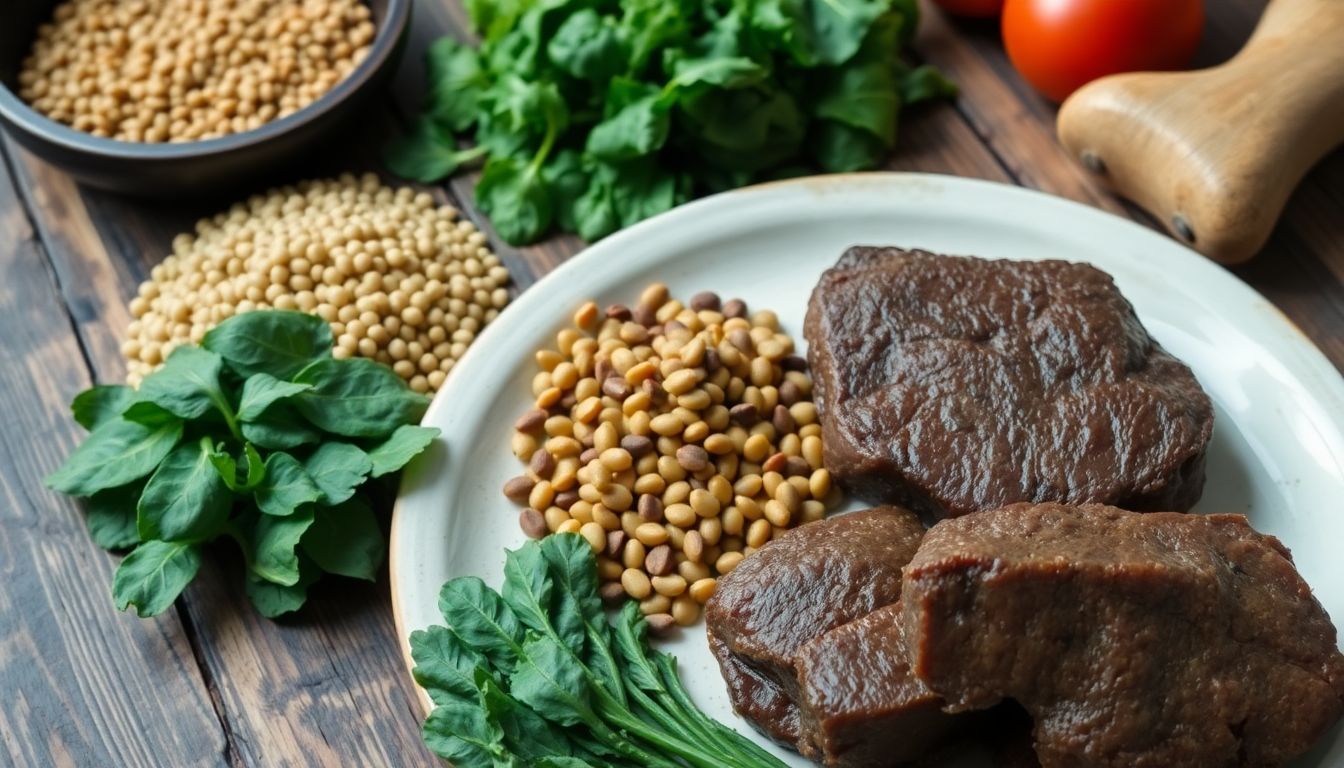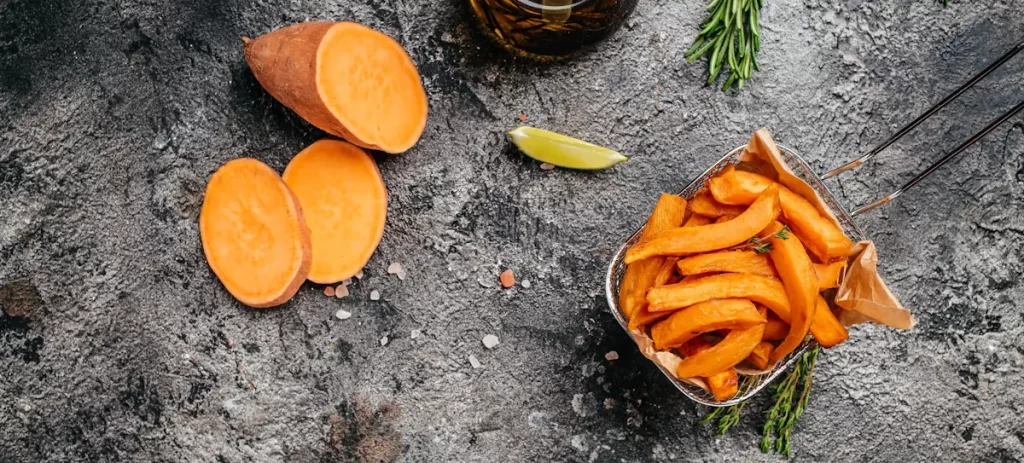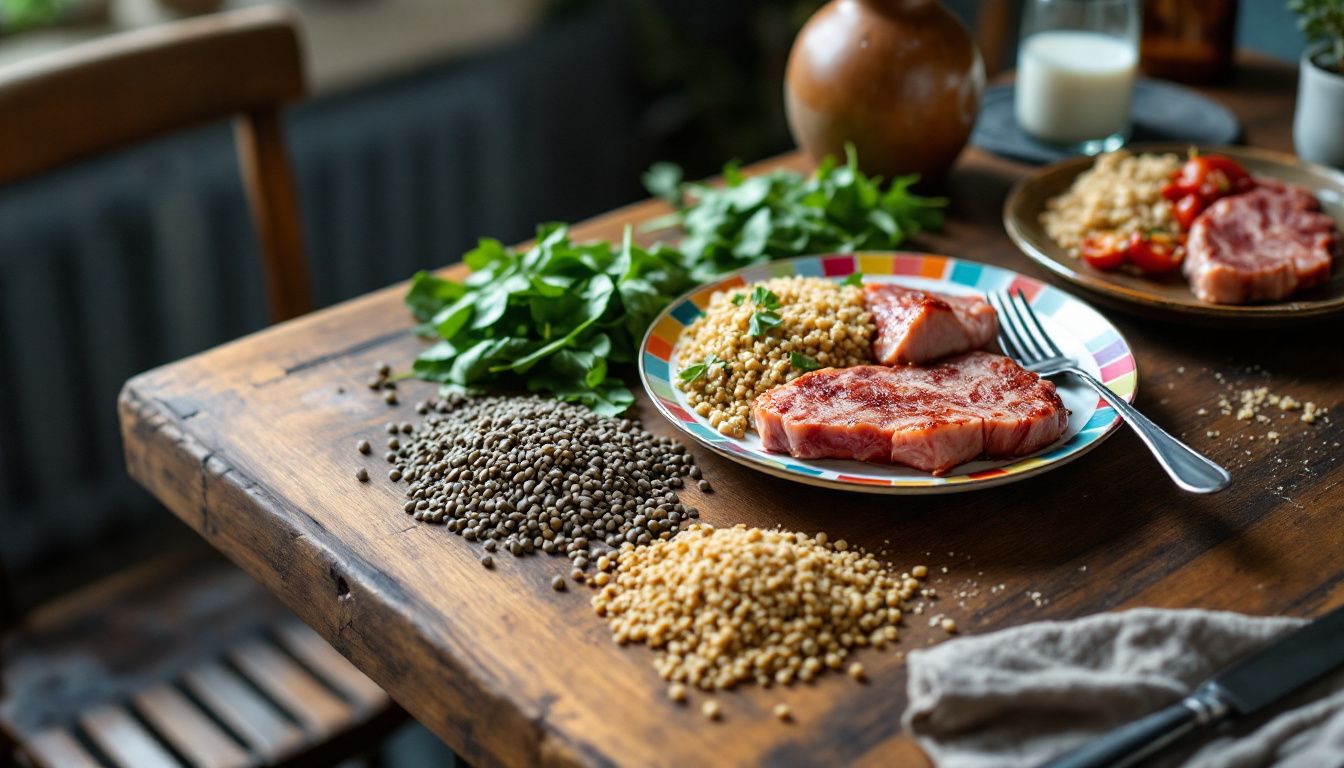Feeling tired or out of breath? You might not be getting enough iron, a key nutrient that helps carry oxygen in your blood. This article will teach you about foods high in iron and how to add them to your meals.
Thank you for reading this post, don't forget to subscribe!Keep reading—it’s easier than you think!
Key Takeaways
- Iron is key for energy, oxygen transport, and red blood cell production. Adult men need 8 mg daily; women aged 19-50 need up to 18 mg or 27 mg if pregnant.
- Heme iron (animal-based) absorbs easily. Examples include oysters (6.9 mg in three), lean beef (2.5 mg in 3 oz.), and liver.
- Non-heme iron (plant-based) includes lentils (6.6 mg per cup) and fortified cereals (up to 9 mg per serving). Pair with vitamin C foods like oranges for better absorption.
- Avoid tea, coffee, calcium-rich drinks, and phytates during iron-heavy meals as they block absorption of the nutrient.
- Cooking with cast iron pans can increase food’s iron content by up to 16%. Use these for acidic dishes like tomato sauce for added benefits!
Essential Iron Needs
Iron helps your body make red blood cells and transport oxygen. Your needs depend on age, gender, and health conditions like pregnancy or celiac disease.
Daily recommended iron intake
Meeting your daily iron needs is crucial for energy, immunity, and overall health. Iron requirements vary based on age, gender, and life stage. Refer to the table below for daily recommendations:
| Group | Age Range | Daily Iron Intake (mg) |
|---|---|---|
| Men | 19 to 50 years | 8 mg |
| Men | 51 years and older | 8 mg |
| Women | 19 to 50 years (not pregnant or breastfeeding) | 18 mg |
| Women | 19 to 50 years (pregnant) | 27 mg |
| Women | 19 to 50 years (breastfeeding) | 9 mg |
| Women | 51 years and older | 8 mg |
Needs change with lifestyle and biology. For example, women aged 19 to 50 years require more iron than men of the same age group. Pregnancy demands the highest intake, 27 mg daily. Older adults, regardless of gender, only need 8 mg per day.
Differences in iron needs by age and gender
Iron requirements change based on age, gender, and specific needs of the body. Understanding these differences ensures you’re meeting your daily goals for optimal health. Here’s a clear breakdown:
| Age Group | Daily Iron Requirement (mg) | Notes |
|---|---|---|
| Birth to 6 months | 0.27 mg | Primarily met through breast milk or formula. |
| 7 to 12 months | 11 mg | Solid foods like fortified cereals are key. |
| 1 to 3 years | 7 mg | Iron is crucial for growth and development. |
| 4 to 8 years | 10 mg | Active children require steady iron levels. |
| 9 to 13 years | 8 mg | Supports early adolescent changes. |
| 14 to 18 years (Females) | 15 mg | Higher needs due to menstruation. |
| 14 to 18 years (Males) | 11 mg | Supports muscle growth during puberty. |
Iron needs vary significantly for teenage girls and boys. Women of reproductive age often require more iron than men, especially during periods of blood loss. Children and infants, growing rapidly, need steady doses to develop properly.
Identifying Iron-Rich Foods
Iron comes from two main types of food: animal-based and plant-based. Each type offers different benefits and absorbs in unique ways.
Heme iron sources: meats and seafood
Heme iron comes from animal-based foods. It is easily absorbed by the body compared to non-heme iron.
- Oysters are a fantastic choice for heme iron. Three oysters provide 6.9 mg of iron, making them a nutrient-packed option.
- Lean beef is another excellent source. A 3-ounce cooked portion offers 2.5 mg of dietary iron and helps maintain healthy red blood cells.
- Liver, especially from beef or chicken, has high amounts of this essential nutrient. It supports oxygen transport in the blood.
- Red meat like lamb or pork delivers a rich amount of heme iron while also being versatile for meals.
- Poultry such as turkey meat and chicken contains moderate levels of this mineral but still contributes to better iron stores.
- Seafood options include clams, shrimp, salmon, and tuna. These are not just nutritious but also rich in vitamins and minerals like vitamin B12.
- Eggs offer smaller amounts but pair well with other iron-rich foods to boost your intake further.

Non-heme iron sources: plants and grains
Non-heme iron comes from plants and grains. It is ideal for vegetarians, vegans, and anyone looking to eat healthier.
- Cooked lentils provide 6.6 mg of iron per cup. They are easy to add to soups or salads.
- Spinach, when cooked, offers 6.4 mg of iron per cup. Pair it with citrus fruits for better absorption.
- Soybeans contain 8.8 mg of iron in a single cooked cup. They can be enjoyed in stir-fries or as tofu dishes.
- White beans, canned and ready to eat, have about 8 mg of iron per cup. Add them to stews or pasta dishes for nutrition boosts.
- Fortified cereals often deliver up to 9 mg of iron per cup serving—check for labels mentioning “fortified.”
- Cream of wheat stands out with 12.8 mg of iron per cooked cup, making it an excellent breakfast choice.
- Pumpkin seeds are great snacks packed with non-heme iron content while also offering other essential nutrients.
- Black beans offer a solid amount of iron while being high in soluble fiber, which aids digestion.
Strategies for Incorporating Iron into Your Diet
Boost your iron intake by pairing certain foods that work well together. Small changes in meals can help your body absorb this key nutrient better.
Combining iron-rich foods with vitamin C for absorption
Pair non-heme iron foods like spinach, beans, or fortified cereals with vitamin C-rich options. Citrus fruits, bell peppers, and tomatoes work well. This pairing helps the body absorb more iron by converting ferric iron into ferrous iron in the gut.
Iron absorption happens mainly in the small intestine—specifically in the duodenum and upper jejunum. Adding a glass of orange juice to your meal or squeezing lemon over leafy greens can make a difference.
Small tweaks improve how your body uses these nutrients efficiently!
Avoiding substances that inhibit iron absorption
Tea and coffee can block iron absorption. Their tannins bind to iron, making it harder for your body to use. Avoid drinking them with meals rich in foods high in iron like lean meats or organ meats.
Calcium-rich drinks also lower how much iron you absorb. Phytates, found in whole grains and legumes, do the same. To keep your iron stores healthy, have these at different times than your main meals.
Cooking Tips to Maximize Iron Intake
Boost iron in your meals with smart cooking habits. Small changes can make a big difference for better nutrient levels.
Using cast iron cookware
Cast iron cookware can add iron to your meals. It releases small amounts of this mineral while cooking, especially in acidic dishes like tomato-based sauces. Studies show it may boost the iron content of food by up to 16%.
This is helpful for people with low iron stores or iron deficiency anemia.
Keep cast iron pans seasoned and clean for best results. A well-maintained skillet will last for years and continue providing health benefits. Use them regularly for cooking foods high in vitamin C, such as Brussels sprouts or cabbage, to improve your body’s ability to absorb the extra dietary iron.
Cooking methods that preserve iron content
Boiling vegetables for too long can reduce their iron content. Instead, steaming or microwaving helps retain more nutrients while cooking. These methods use less water, so the iron stays in the food.
Using cast iron cookware for meals boosts your iron intake. Studies show it can increase absorption by up to 3 times. Cooking acidic foods like tomato sauce in a cast iron pan releases even more dietary iron into the dish.

Addressing Iron Deficiency
Iron deficiency can cause tiredness, pale skin, or dizziness. If untreated, it may lead to more serious health problems like iron-deficiency anemia.
Recognizing symptoms of iron deficiency
Iron deficiency can sneak up on you and affect your daily life. It lowers oxygen transport in your body, causing several noticeable issues.
- Fatigue is one of the most common signs. You may feel tired even after sleeping well.
- Shortness of breath during simple activities might occur, like climbing stairs or walking briskly.
- Dizziness can strike suddenly and make it hard to focus or stay balanced.
- Upset stomach, including nausea or cramps, may happen as a less obvious symptom.
- Headaches could become frequent due to reduced oxygen flow to the brain.
- Pale skin may appear, especially in areas like the face or nails, showing low red blood cell levels.
- Cold hands and feet are a result of poor circulation caused by low hemoglobin production.
- Difficulty concentrating at work or school might increase as your brain gets less oxygen.
- Weakness in muscles can develop because iron helps energy production throughout your body.
These symptoms shouldn’t be ignored if they persist or worsen over time!
When to seek medical advice
Persistent fatigue or weakness should raise concern. Pale skin, brittle nails, or shortness of breath may signal iron-deficiency anemia. Unexplained dizziness or headaches could also point to low iron levels.
Seek medical care if symptoms worsen despite dietary changes. Blood tests like those for hemoglobin and ferritin can confirm deficiency. In severe cases, treatments such as iron supplements or intravenous iron might be needed.
Pregnant women and people with gastrointestinal conditions are at higher risk for complications and require timely intervention.
Quick and Healthy Meal Ideas for Busy Nights
Sometimes, busy nights call for quick yet nutritious meals. These ideas are simple, delicious, and rich in iron to keep you energized.
- Steak with Goulash Sauce and Sweet Potato Fries
Cook a juicy steak in under 35 minutes. Pair it with a hearty goulash sauce and baked sweet potato fries for a well-balanced dinner. - Spinach, Sweet Potato, and Lentil Dhal
A vegetarian option packed with non-heme iron. This creamy dish takes less than an hour to prepare and is full of flavor. - Grilled Salmon with Steamed Kale
Grill salmon for omega-3s and heme iron. Add steamed kale—a cruciferous vegetable—for extra vitamins like vitamin C. - Beef Stir-Fry with Broccoli and Bell Peppers
Use lean beef for protein and iron. Toss in fresh broccoli and bell peppers to boost vitamin C levels and aid absorption. - Organ Meat Tacos with Citrus Salsa
Try liver tacos for high heme iron content. Add a zesty citrus salsa for better iron absorption from the meal. - Quinoa Salad with Chickpeas and Dark Chocolate Shavings
Plant-based foods like quinoa and chickpeas are easy sources of non-heme iron. Sprinkle dark chocolate shavings for an antioxidant punch. - Fortified Cereal Bowl with Berries
Choose fortified cereal high in iron daily value percentages. Top it off with vitamin-C-rich berries like strawberries or raspberries to help your body absorb the nutrients faster.
Conclusion
Eating foods high in iron can boost your energy and support healthy red blood cells. Focus on adding meats, seafood, beans, and leafy greens to your meals. Pair them with vitamin C-rich foods like citrus fruits for better absorption.
Keep an eye on your iron levels to avoid deficiencies or overloads. A well-balanced diet makes all the difference!
For more quick and healthy meal ideas that incorporate iron-rich foods into your busy evenings, check out our article “Food Shortcuts for Busy Nights: Quick & Healthy Meal Ideas”.
